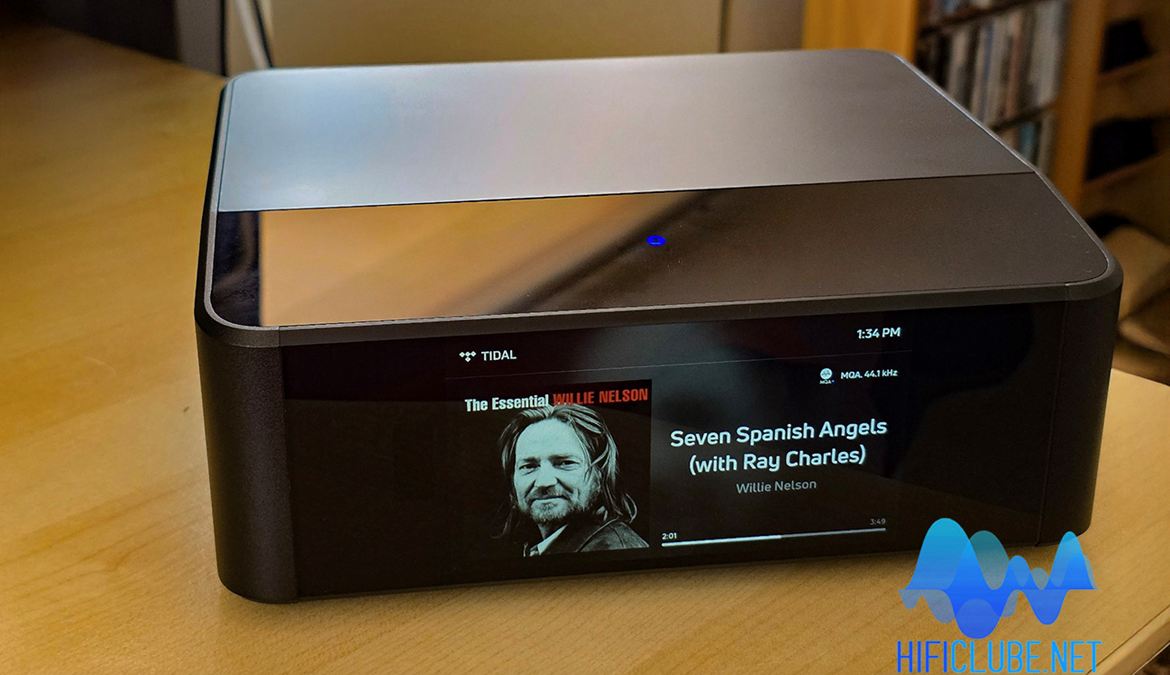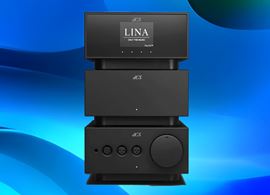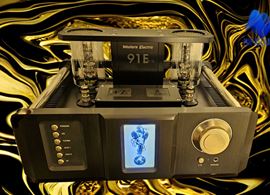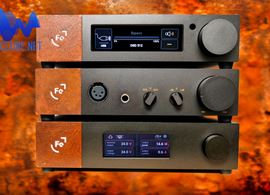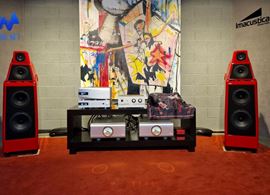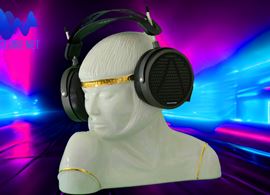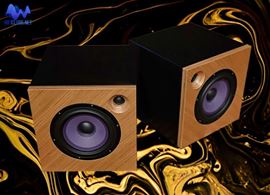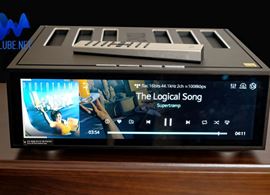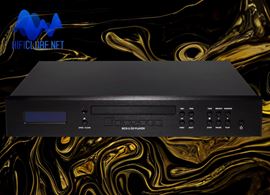You can’t stop time. And if hi-fi is to survive, it must keep pace with progress. Knowing this, Bluesound introduces the new Node ICON, a streamer-DAC that combines digital precision engineering with human listening experience, all available for €1,098.99.
In digital music, time plays a crucial role as well. And it is precisely in the realm of time, more than in the frequency domain, that the Node ICON aims to revolutionize digital audio.
Form and function
The Node ICON is a step forward in design. Out goes the matte plastic; in comes the anodized aluminum of the slightly larger chassis that now makes its presence felt. Finally, Bluesound has listened to its users and installed a 5-inch color screen on the front: a window to the musical universe, with album covers, metadata, and even a clock when in standby mode.
At the top, the familiar glass panel was retained, featuring backlit, fingerprint-prone touch controls and a proximity sensor that helps prevent further fingerprints. The available functions are limited. Why not incorporate a full front touchscreen? Like in the Eversolo Play, for example. A physical volume button would also come in handy, literally.
The Eversolo Play has touchscreen and a twist of Class D amplification, while the Node ICON (on top) offers balanced preamp and double headphone outputs.
The rear connections are quite comprehensive and well arranged: balanced RCA and XLR analog outputs (a first for the range), optical, coaxial and USB-A and C digital inputs/outputs, combined RCA/optical input, HDMI eARC for TV connection, and a dedicated subwoofer output. There are also two 6.35 mm headphone outputs with THX AAA amplification, inherited from the Node X, discreetly placed on each side. A true digital hub. The HDMI input accepts formats up to Dolby Digital 5.1, down mixing to 2.1, so you can incorporate the Node ICON into a stereo AV system.
The rear connections are quite comprehensive and well arranged.
Inside the box
The Node ICON incorporates two ESS Sabre ES9039Q2M DACs in a dual-mono configuration, with 24-bit/192 kHz processing and support for DSD256 (with internal conversion to PCM). MQA files are fully decoded up to 352.8 kHz, as is traditional with Bluesound. MQA files are increasingly rare now that Tidal has abandoned the format. But I still have plenty of them for testing.
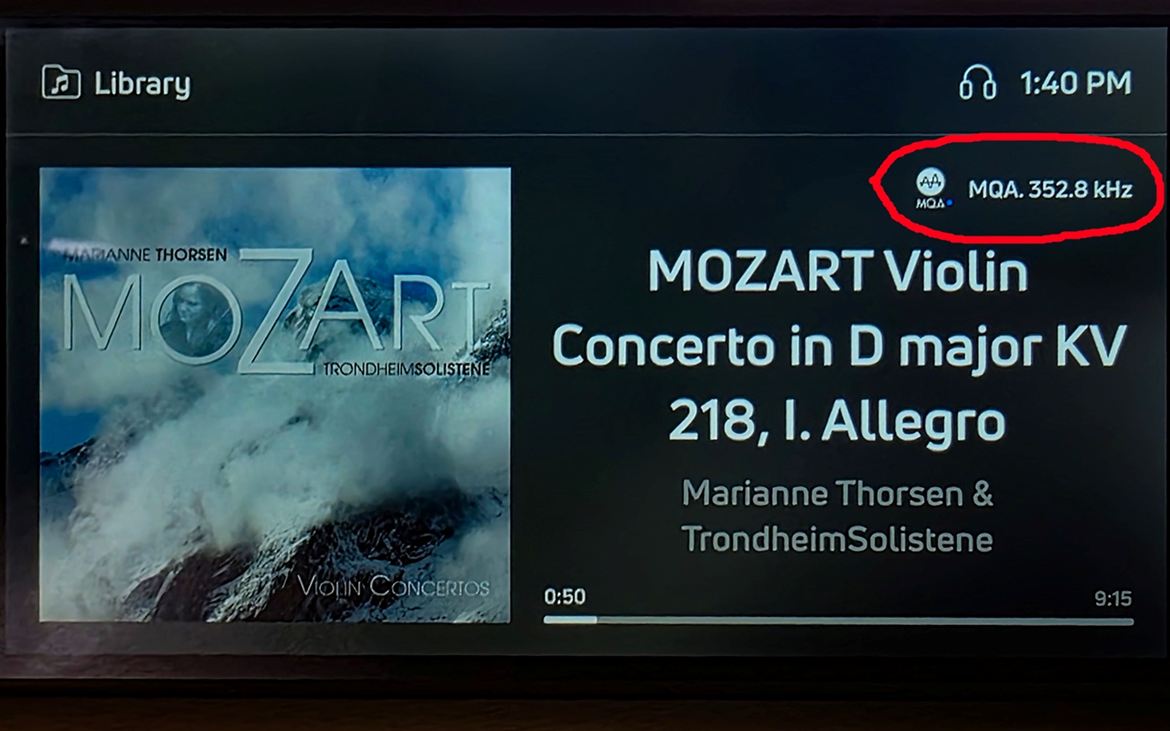
The ICON fully decodes MQA files up to 352.8 kHz
The digital heart is powered by a quad-core ARM Cortex-A53 processor, and the firmware, of course, is BluOS, a proven and highly functional platform. Compatible with AirPlay 2, Spotify Connect, Tidal Connect, Roon Ready, Bluetooth 5.2 aptX Adaptive, Wi-Fi 5, Dirac Live (licence and microphone sold separately), and multiroom. It makes everything but coffee.
Note: Less invasive than Dirac are the tone controls: bass and treble. However, beware: when activated, even at 0 dB, the volume is reduced by 6 dB.
BluOS app
The BluOS app is one of the best on the market. Complete, reliable, and intuitive, with a smooth learning curve. It allows you to do everything from creating multiroom groups to setting crossovers for subwoofers, pairing Bluetooth headphones, or controlling the screen brightness. Navigation between inputs could be more user-friendly, but it doesn't compromise.
Bluetooth, with aptX Adaptive and Two-Way function, allows you to receive and transmit wireless audio with very acceptable quality. It's not lossless, but it's close. Ideal for listening with wireless headphones at the end of the day or sharing a quick track with a friend or family member.
The Filter of Discord
Here lies the soul of the Node ICON. But it is also its most controversial asset.
Bluesound has integrated a new MQA Qrono d2a digital filter, optimised for the ESS DAC used. This is a slow-sloping filter with minimal pre-ringing, optimized to preserve temporal coherence at the expense of ultrasonic noise suppression.
Lenbrook, which owns both Bluesound and NAD, acquired MQA in 2023, making the Node Icon one of the first products to feature this technology. Note: Read below ‘Digital With An Analogue Soul’
This MQA filter is not a brick-wall or fast linear-phase type; therefore, in laboratory measurements, the Node ICON may exhibit some ultrasonic noise above the audio band. You can't hear the noise, but you can measure it. However, it offers the advantage of being more temporally coherent and pleasing to the ear. And some say it sounds better. I do. And that's the crux of the matter: engineering versus emotion; measurements versus music.
Objectivist reviewers oppose, with some justification, the choice of a filter that could theoretically cause problems in amplifiers (and speakers) that are sensitive to ultrasound. However, there are also critics and users like me who hear better focus and more stage presence. The sound becomes more fluid and loses its harshness. And neither the amplifiers nor the speakers I paired the ICON with experienced issues due to ultrasonic quantization noise. None.
Bluesound's choice is intentional and cannot be reversed, as you cannot switch to one of seven different digital filters like with the competition, at least until a firmware update is provided.
Are the ICON and the MQA filter then inextricably linked? Maybe not.
The Node ICON offers a rich, emotionally satisfying, temporally coherent listening experience with features rarely found in a single device.
Escape Door
For those who disagree with the philosophy behind the MQA Qrono filter or simply prefer to entrust the digital-to-analog conversion to an external DAC of their choice, I have found a simple and effective solution: activate Digital Passthrough mode in the Node ICON settings. This mode sends the original digital signal without any additional processing—including without applying the Qrono filter—through the coaxial, optical, or USB Audio outputs.
When choosing this route, you must first opt for fixed digital volume output and disable the tone controls, which operate in the digital domain.
High-quality streamer
This way, the Node ICON acts as a pure transport, doing what many streamers cannot do as efficiently: delivering a clean and stable digital stream with excellent compatibility and synchronization, suitable for high-end external DACs. In other words, it can function solely as a high-quality streamer, too.
I connected the ICON to a Luxsin X9 (preamp/headamp/DAC), which in turn was connected to a LAB12 Mighty amplifier and a pair of Radiant Clarity 4.2 speakers or a pair of Austrian Audio The Composer headphones. Then I just needed to enable/disable “Passthrough” mode in the app to do an instant A/B comparison.
Is the difference worth the bother? In a blind test, if I had to put my head on the chopping block, I would say that I didn't hear any substantial difference, just to be cautious. If there are any audible differences in this empirical A/B comparison, they favour the ICON's MQA filter. So, leave it as it is and thoroughly enjoy the ICON straight out of the box.
Conclusion
Bluesound aimed to demonstrate that it could create a superior Node compared to its predecessors that can compete with the big boys. And I think it has succeeded. It's not perfect. It's not cheap. And it may not appeal to the most orthodox objectivists. But it offers a rich, emotionally satisfying, temporally coherent listening experience with features rarely found in a single device.
It's a streamer, a DAC, a digital preamplifier, a Bluetooth receiver, a TV extension, and a multiroom center. All this in a single elegant and discreet chassis. And it sounds good. Superb. Not least because I can also connect it to an amplifier of my choice, unlike the Eversolo Play, which has amplification but no preamp or headphone output.
If you believe that listening to music is more than analysing graphs and that, when it comes to music playback, timing is as important as, if not more so than, flat frequency. The Node ICON could be the missing piece in your system. It is a winner!
Just listen:
‘Don't Know ’Why’—Norah Jones (24-bit/96kHz)
Norah Jones's voice takes centre stage with an almost tangible presence, as if the Node ICON is pulling her from a deep well of silence. The breathing, the pauses, the gentle strumming of the guitar—everything feels precisely defined, yet without over-analysis. The timing is organic and natural, with the Qrono filter acting as an ally to the emotion conveyed by the LAB12 Mighty valves, maintaining the warmth of the performance. The bass has body without being too dominant, and the piano notes float in the studio air like soap bubbles.
‘So What’—Miles Davis (Kind of Blue, 24-bit/192kHz MQA)
Here, the magic lies in the spaces between the notes. The Node ICON creates the sensation of a recording studio in the room with the touch of a sound architect: the distance between musicians, the echo of wind instruments, and the subtle murmur of the rhythm section. Miles' trumpet attack is nimble and clear, without being aggressive, and the cymbals seem to vanish in the studio air like water vapor while the notes linger gracefully. The instrumental separation does not compromise tonal cohesion, ensuring that each element sounds cohesive and avoids sounding isolated from the context. Here, the MQA filter seems to bring us closer to the original 1959 session, as if viewed through a cinematographic filter.
‘Everything In Its Right Place’—Radiohead ’(16-bit/44.1kHz, FLAC)
Even with a ‘normal’ resolution file, the Node ICON reveals its capabilities by showcasing the successive layers that compose the mix: synthesizers, distorted almost diabolic voices, pulsating bass. Everything is well-balanced tonally. Above all, there is rhythm: the electronic beat vibrates with controlled tension. Here, I preferred to connect it to a Musical Fidelity B1 xi, which is raw, with more energy and dynamics than the Mighty, and it carried the small Radiant Acoustics Clarity 4.2 speakers to the altar of music appreciation.
Find out about the possibility of listening to the Node ICON integrated into your system at:




